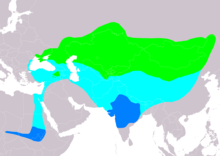蓑羽鹤
| 蓑羽鹤 | |
|---|---|

| |
| 科学分类 | |
| 界: | 动物界 Animalia |
| 门: | 脊索动物门 Chordata |
| 纲: | 鸟纲 Aves |
| 目: | 鹤形目 Gruiformes |
| 科: | 鹤科 Gruidae |
| 属: | 鹤属 Grus |
| 种: | 蓑羽鹤 G. virgo
|
| 二名法 | |
| Grus virgo Linnaeus, 1758
| |

| |
| Range of G. virgo 繁殖区 过境 非繁殖区
| |
| 异名 | |
| |

蓑羽鹤(学名:Grus virgo),又名闺秀鹤、处子鹤,是一种生活在欧罗西伯利亚中部的鹤类,分布范围从黑海到蒙古和中国东北。在土耳其也有少量繁殖群体。这些鹤是候鸟。来自欧亚西部的鸟类会在非洲过冬,而来自亚洲、蒙古和中国的鸟类则会在印度次大陆过冬。这种鸟在印度文化中具有象征意义,被称为Koonj或Kurjaa。[3]
分类
[编辑]蓑羽鹤由瑞典博物学家卡尔·林奈于1758年在他的第十版自然系统中正式描述。他将其与鹭和鹤一起归入苍鹭属(Ardea),并创造了双名Ardea virgo。他将模式产地指定为东方,但后来被限定为印度。[4][5] 林奈引用了早期作者的记述。英国博物学家伊莱亚萨·阿尔宾于1738年描述并绘制了“努米底亚鹤”。阿尔宾解释说:“这种鸟被称为Demoiselles是因为它有一些动作,似乎模仿了女人在走路、行礼和跳舞时追求优雅的姿态。”[6] 林奈还引用了英国博物学家乔治·爱德华兹于1750年描述并绘制的“努米底亚的Demoiselle”。[7] “努米底亚的Demoiselle”这个名称由法国博物学家克劳德·佩罗于1676年首次使用。[8] 现在,蓑羽鹤被归入由法国动物学家马蒂兰·雅克·布里松于1760年引入的鹤属(Grus)。该物种被视为单型:不承认任何亚种。[9] 属名Grus是拉丁语“鹤”的意思。种小名virgo是拉丁语,意思是“少女”。[10] 一些权威机构将此物种与密切相关的蓝鹤(Grus paradisea) 一起归入Anthropoides属。[1][11][12]
描述
[编辑]蓑羽鹤长85—100 cm(33.5—39.5英寸),身高76 cm(30英寸),翼展155—180 cm(61—71英寸)。它重2—3千克(4.4—6.6磅)。它是最小的鹤类物种。[13][14] 蓑羽鹤略小于灰鹤,但具有类似的羽毛。它有一条长长的白色颈带,黑色从前颈延伸至胸部形成羽冠。
它的鸣声声比灰鹤更高,像其他鹤类一样有舞蹈表现,动作比灰鹤更优雅,跳跃较少。
分布与栖地
[编辑]蓑羽鹤在欧亚大陆中部从黑海到蒙古和中国东北地区繁殖。它通常在植被稀疏的开放区域,通常靠近水域繁殖。在冬季,它会迁徙到萨赫勒地区的非洲,从乍得湖东部到埃塞俄比亚南部,或迁徙到印度次大陆的西部地区。土耳其曾有一个小型群体,北非的阿特拉斯山脉也曾有一个独立的留鸟群体,这些都已经灭绝。在印度的越冬地,它们会在农田上形成大型群体,夜间在浅水区栖息。[12][15]
行为与生态
[编辑]繁殖
[编辑]蛋在四月到五月间产下。简陋的巢通常置于草地或裸地上的开放区域。每次产下两枚蛋,间隔一天,并在第一枚蛋产下后开始孵化。孵化由双亲共同完成,但主要由雌鸟负责。蛋在27到29天后不会同步孵化。雏鸟上面为淡棕色,下面为灰白色。它们由双亲共同喂养和照顾。离巢期在55到65天之间。它们在两岁时首次繁殖。[16][17]
文化意义
[编辑]在北印度的语言中,蓑羽鹤被称为koonj/kurjan,并在该地区的文学、诗歌和习语中占有重要地位。美丽的女性常被比作koonj,因为它细长的形态被认为优雅。人们也经常将koonj比作远行或冒险归来的人。[18]
名称koonj来自梵语词汇kraunch,这是印欧语系中“鹤”的同源词。[3] 在印度教史诗罗摩衍那的作者蚁垤的古老故事中,据说他的第一首诗是灵感来自于看到一名猎人杀死了一对正在求爱的蓑羽鹤中的雄鸟。当他观察到伤心的雌鸟在空中盘旋并哀鸣时,他在诗中诅咒了猎人。由于传统上认为此刻之前的所有诗歌都是由神启示而非人类创作的,这首关于蓑羽鹤的诗被视为人类创作的第一首韵文。[19][可疑]
在迁徙过程中,koonj的飞行编队也启发了古印度的阵法。在摩诃婆罗多史诗中描述,俱卢之战第二天,双方都采用了koonj编队。[20]
参考文献
[编辑]- ^ 1.0 1.1 BirdLife International. Anthropoides virgo. The IUCN Red List of Threatened Species. 2018, 2018: e.T22692081A131927771 [14 February 2022]. doi:10.2305/IUCN.UK.2018-2.RLTS.T22692081A131927771.en
 .
.
- ^ Appendices | CITES. cites.org. [2022-01-14]. (原始内容存档于2017-12-05).
- ^ 3.0 3.1 R. K. Gaur, Indian Birds, Brijbasi Printers, 1994, 1994, ISBN 9788171070312,
... The smallest member of the crane family, the demoiselle crane (Anthropoides virgo ) is a distinctive looking bird, with ashy grey ... The local name for this crane — koonj — is onomatopoeic, deriving from the Sanskrit 'kraunch', the origin of the word crane itself ...
- ^ Linnaeus, Carl. Systema Naturae per regna tria naturae, secundum classes, ordines, genera, species, cum characteribus, differentiis, synonymis, locis 1 10th. Holmiae (Stockholm): Laurentii Salvii. 1758: 141 [2024-08-21]. (原始内容存档于2023-09-03) (Latin).
- ^ Peters, James Lee (编). Check-List of Birds of the World 2. Cambridge, Massachusetts: Harvard University Press. 1934: 153–154.
- ^ Albin, Eleazar; Derham, William. A Natural History of Birds : Illustrated with a Hundred and One Copper Plates, Curiously Engraven from the Life 3. London: Printed for the author and sold by William Innys. 1738: 78, Plate 83.
- ^ Edwards, George. A Natural History of Uncommon Birds 3. London: Printed for the author at the College of Physicians. 1750: 134, Plate 134 [2024-08-21]. (原始内容存档于2024-07-27).
- ^ Perrault, Claude. Mémoires pour Servir à l’Histoire Naturelle des Animaux. Paris: Imprimerie royale. 1676: 157-162, Plate [2024-08-21]. (原始内容存档于2024-07-27) (French).
- ^ Gill, Frank; Donsker, David; Rasmussen, Pamela (编). Finfoots, flufftails, rails, trumpeters, cranes, Limpkin. IOC World Bird List Version 14.1. International Ornithologists' Union. December 2023 [25 July 2024]. (原始内容存档于2023-03-14).
- ^ Jobling, James A. The Helm Dictionary of Scientific Bird Names. London: Christopher Helm. 2010: 179, 403. ISBN 978-1-4081-2501-4.
- ^ Clements, J.F.; Rasmussen, P.C.; Schulenberg, T.S.; Iliff, M.J.; Fredericks, T.A.; Gerbracht, J.A.; Lepage, D.; Spencer, A.; Billerman, S.M.; Sullivan, B.L.; Wood, C.L. The eBird/Clements checklist of birds of the world: v2023. 2023 [26 July 2024]. (原始内容存档于2013-10-13).
- ^ 12.0 12.1 Archibald, G.W.; Meine, C.D. Family Gruidae (Cranes)
 . del Hoyo, J.; Elliott, A.; Sargatal, J. (编). Handbook of the Birds of the World. 3: Hoatzin to Auks. Barcelona, Spain: Lynx Edicions. 1996: 60-89 [83-84]. ISBN 978-84-87334-20-7.
. del Hoyo, J.; Elliott, A.; Sargatal, J. (编). Handbook of the Birds of the World. 3: Hoatzin to Auks. Barcelona, Spain: Lynx Edicions. 1996: 60-89 [83-84]. ISBN 978-84-87334-20-7.
- ^ Demoiselle Crane, Int. Crane Foundation
- ^ Ali, S. The Book of Indian Birds. Bombay: Bombay Natural History Society. 1993. ISBN 978-0-19-563731-1.
- ^ Ilyashenko, E.I.; Mudrik, E.A.; Andryushchenko, Y.A.; Belik, V.P.; Belyalov, O.V.; Wikelski, M.; Gavrilov, A.E.; Goroshko, O.A.; Guguyeva, E.V.; Korepov, M.V.; Mnatsekanov, R.A.; Politov, D.V.; Postelnykh, K.A.; Lei, C.; Ilyashenko, V.Y. Migrations of the Demoiselle Crane (Anthropoides virgo, Gruiformes): remote tracking along flyways and at wintering grounds. Biology Bulletin. 2022, 49 (7): 863–888. doi:10.1134/S1062359022070068.
- ^ Johnsgard, Paul A. Demoiselle Crane (Anthropoides virgo). Cranes of the World. Bloomington: Indiana University Press. 1983: 95–102 [2024-08-21]. (原始内容存档于2024-07-29). Also available from the Internet Archive here (registration required).
- ^ Cramp, Stanley (编). Grus virgo Demoiselle crane. Handbook of the Birds of Europe the Middle East and North Africa. The Birds of the Western Palearctic. II: Hawks to Bustards. Oxford: Oxford University Press. 1980: 631–636. ISBN 978-0-19-857505-4.
- ^ Department of English, University of Delhi. The Individual and Society. Pearson Education India, 2005. September 2005. ISBN 978-81-317-0417-2.
... kunj: more properly koonj is a demoiselle crane. The word is used metaphorically for a young bride far from her home ...
- ^ Dinkar Joshi; Yogesh Patel. Glimpses of Indian Culture. Star Publications, 2005. 2005. ISBN 978-81-7650-190-3.
... Valmiki saw a pair of kraunch (cranes) birds making love. Suddenly, a hunter killed the male kraunch with an arrow. Valmiki was moved by the cries of the female ... Valmiki's pain was expressed through a shloka ... The first man-composed meter ...
- ^ Ramesh Menon. The Mahabharata: A Modern Rendering. iUniverse, 2006. 20 July 2006. ISBN 978-0-595-40188-8.
... The second day: Two kraunchas ... Yudhishtira decides to form his legions in the vyuha called the krauncha, after the crane ...
外部链接
[编辑]- eBird Species Factsheet (页面存档备份,存于互联网档案馆)
- Demoiselle crane (页面存档备份,存于互联网档案馆) at Animal Diversity Web
- Demoiselle Crane (Anthropoides virgo) (页面存档备份,存于互联网档案馆) from Cranes of the World (1983) by Paul Johnsgard

